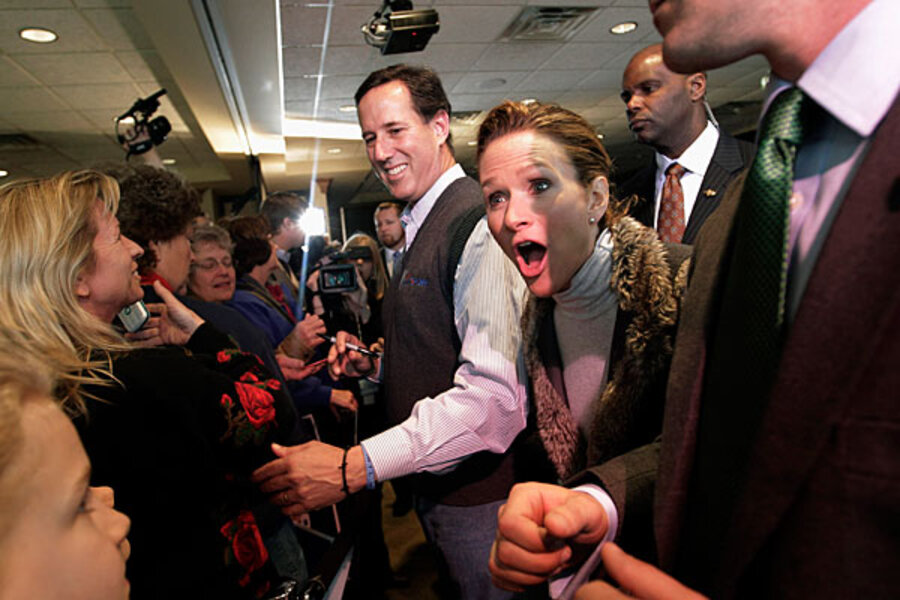Why Rick Santorum's once-generous lead in Wisconsin is eroding
Loading...
| Chicago
By the time Mitt Romney arrives in Wisconsin Friday – his first campaign stop in the state before its GOP primary on Tuesday – his challenger Rick Santorum will have already become a familiar face. Mr. Santorum has been in Wisconsin since last weekend and has dined, bowled, and played shuffleboard with residents in every pocket of the state. He’s even tossed a football at Lambeau Field, home of the Green Bay Packers.
Not that any of it will necessarily help him on Tuesday.
Santorum’s once-generous lead in Wisconsin is eroding. In February, the former US senator polled at 34 percent among the state’s likely Republican voters, while Mr. Romney, the former Massachusetts governor, trailed far back at 18 percent, according to a Marquette University Law School poll.
Current Wisconsin polling shows Romney leading, 39 percent to Santorum’s 31 percent.
What happened? The easy answer is money. The Romney campaign is armed with seemingly unlimited campaign resources to flood local airwaves and phone banks, resulting in the candidate not necessarily having to step foot in the state until just before its voters head to the booths.
By early this week in Wisconsin, combined spending by the Romney campaign and Restore Our Future, a pro-Romney “super political-action committee,” totaled about $2 million in television advertising, much of it negative. By contrast, Santorum’s campaign had spent under $100,000 by last Sunday, according to the Milwaukee Journal Sentinel, and the Red White and Blue Fund, a super PAC backing Santorum, had spent about $300,000.
Santorum’s feet on the ground versus Romney’s pocketbook “has been the pattern in a lot of primary states,” especially since Super Tuesday, says Marquette University law professor and polling director Charles Franklin. While Santorum is trying to show “he’s more invested in the state personally ... Romney’s media campaign is more or less dominating the airwaves.”
The bankroll disparity is frequently referenced at Santorum campaign stops to support the candidate’s narrative that he is a working-class underdog being outflanked by an out-of-touch, Harvard-educated former investment manager.
“We’re fighting hard. Governor Romney is supposedly spending $3.5, $4 million here. We’re not. When you’re that badly outspent, it’s hard to win,” Santorum told a crowd in Beaver Dam Tuesday.
But spending may not be the key factor in why Santorum is slipping in Wisconsin polls. Since February, Santorum’s positions on social issues such as his opposition to birth control, as well as his comments that President Obama is a “snob” for advocating college education, have dominated the media’s coverage of his campaign – possibly turning off independent voters, particularly women.
John McAdams, a political scientist at Marquette University in Milwaukee, says what Santorum meant in those comments was “not terrible,” but they became gaffes because he could not articulate his positions in a way that sounded reasonable.
“Clearly he said some things that were imprudent to say and were controversial, and sometimes voters don’t key in on the substance of what a candidate says but are put off by the controversy,” Professor McAdams says.
Still, Santorum does have some hopeful things to point to in Wisconsin. His polling numbers have dropped just three points in Wisconsin since February. And according to the Marquette poll, his favorability rating among Republican voters in the state remains positive. Plus, Santorum ranks well when it comes to his conservative identity: Forty-two percent of likely GOP voters in Wisconsin say he has the best moral character, with Romney coming in at 29 percent.
At the same time, however, voters are starting to shift support to Romney because they perceive he is the only candidate who has a chance of beating Mr. Obama in November. Although the Marquette poll shows Romney trailing Obama 43 percent to 48 percent, Santorum’s matchup is worse: 39 percent to 51 percent.
“It’s Romney’s game more, much more, than Santorum’s collapse,” says Professor Franklin. “The [Republican] Party is beginning to see [Romney] as the likely nominee, and that’s acceptable now that we’re down to two candidates.”





